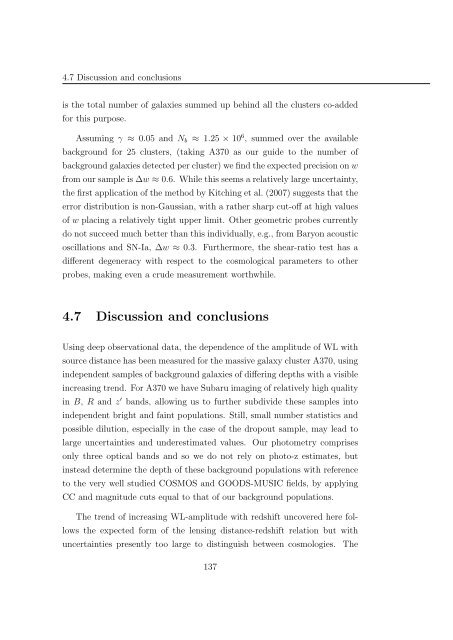Mass and Light distributions in Clusters of Galaxies - Henry A ...
Mass and Light distributions in Clusters of Galaxies - Henry A ...
Mass and Light distributions in Clusters of Galaxies - Henry A ...
Create successful ePaper yourself
Turn your PDF publications into a flip-book with our unique Google optimized e-Paper software.
4.7 Discussion <strong>and</strong> conclusions<br />
is the total number <strong>of</strong> galaxies summed up beh<strong>in</strong>d all the clusters co-added<br />
for this purpose.<br />
Assum<strong>in</strong>g γ ≈ 0.05 <strong>and</strong> N b ≈ 1.25 × 10 6 , summed over the available<br />
background for 25 clusters, (tak<strong>in</strong>g A370 as our guide to the number <strong>of</strong><br />
background galaxies detected per cluster) we f<strong>in</strong>d the expected precision on w<br />
from our sample is ∆w ≈ 0.6. While this seems a relatively large uncerta<strong>in</strong>ty,<br />
the first application <strong>of</strong> the method by Kitch<strong>in</strong>g et al. (2007) suggests that the<br />
error distribution is non-Gaussian, with a rather sharp cut-<strong>of</strong>f at high values<br />
<strong>of</strong> w plac<strong>in</strong>g a relatively tight upper limit. Other geometric probes currently<br />
do not succeed much better than this <strong>in</strong>dividually, e.g., from Baryon acoustic<br />
oscillations <strong>and</strong> SN-Ia, ∆w ≈ 0.3. Furthermore, the shear-ratio test has a<br />
different degeneracy with respect to the cosmological parameters to other<br />
probes, mak<strong>in</strong>g even a crude measurement worthwhile.<br />
4.7 Discussion <strong>and</strong> conclusions<br />
Us<strong>in</strong>g deep observational data, the dependence <strong>of</strong> the amplitude <strong>of</strong> WL with<br />
source distance has been measured for the massive galaxy cluster A370, us<strong>in</strong>g<br />
<strong>in</strong>dependent samples <strong>of</strong> background galaxies <strong>of</strong> differ<strong>in</strong>g depths with a visible<br />
<strong>in</strong>creas<strong>in</strong>g trend. For A370 we have Subaru imag<strong>in</strong>g <strong>of</strong> relatively high quality<br />
<strong>in</strong> B, R <strong>and</strong> z ′ b<strong>and</strong>s, allow<strong>in</strong>g us to further subdivide these samples <strong>in</strong>to<br />
<strong>in</strong>dependent bright <strong>and</strong> fa<strong>in</strong>t populations. Still, small number statistics <strong>and</strong><br />
possible dilution, especially <strong>in</strong> the case <strong>of</strong> the dropout sample, may lead to<br />
large uncerta<strong>in</strong>ties <strong>and</strong> underestimated values. Our photometry comprises<br />
only three optical b<strong>and</strong>s <strong>and</strong> so we do not rely on photo-z estimates, but<br />
<strong>in</strong>stead determ<strong>in</strong>e the depth <strong>of</strong> these background populations with reference<br />
to the very well studied COSMOS <strong>and</strong> GOODS-MUSIC fields, by apply<strong>in</strong>g<br />
CC <strong>and</strong> magnitude cuts equal to that <strong>of</strong> our background populations.<br />
The trend <strong>of</strong> <strong>in</strong>creas<strong>in</strong>g WL-amplitude with redshift uncovered here follows<br />
the expected form <strong>of</strong> the lens<strong>in</strong>g distance-redshift relation but with<br />
uncerta<strong>in</strong>ties presently too large to dist<strong>in</strong>guish between cosmologies. The<br />
137
















